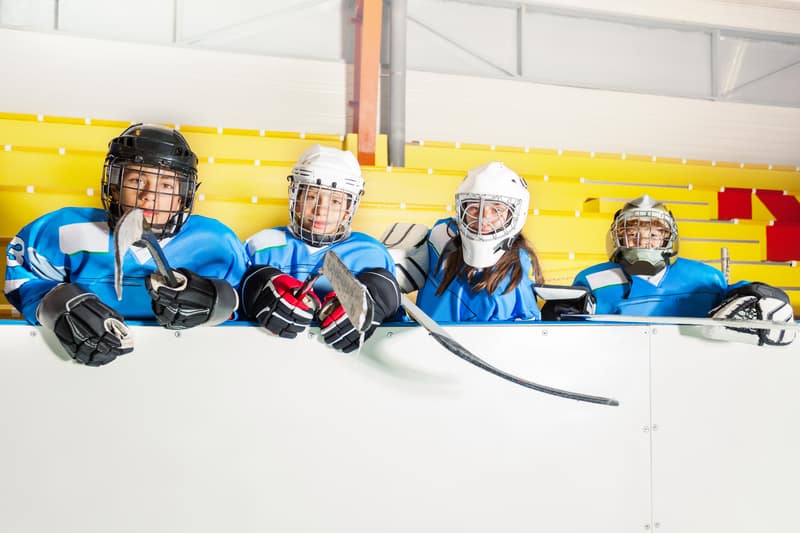
When it comes to hockey divisions, its important to know where your child will be playing and what level of hockey he or she will be in. When your kids are 4 or 5 this doesn’t matter as much because they are just starting.
But when they get older they will be able to try out for more advanced levels of hockey. It is important to know a little about each division of hockey.
Here are the divisions and associated age groups for levels of hockey in Canada
| Division | Age Group |
| Initiation (U7 starting in 2020/2021) | 4-6 |
| Novice (U9 starting in 2020/2021) | 7-8 |
| Atom (U11 starting in 2020/2021) | 9-10 |
| PeeWee (U13 starting in 2020/2021) | 11-12 |
| Bantam (U15 starting in 2020/2021) | 13-14 |
| Midget (U18 starting in 2020/2021) | 15-18 |
| Juvenile (under 20) | 19-20 |
| Junior (under 21) | 20-21 |
| Senior | No Age Limit |
Quebec and British Columbia have a little bit different of a designation for their levels of hockey. Down below we will cover a little bit on each level to give you the best understanding of what to expect.
Theres a lot of information and it can get a little complicated when you get into the competitive side of the sport, so lets dive in and get our learning on.
U7 (Initiation)
This is where it all begins. The U7 (under 7) Timbits Initiation Program, this level is about one thing, ok maybe more than one. But the first and foremost it is about FUN. The idea is to give children a positive and good first impression to hockey. So they can enjoy hockey for years to come.
In initiation the focus on fair play and developing basic hockey skills. According to Hockey Canada, the focus is on these four goals
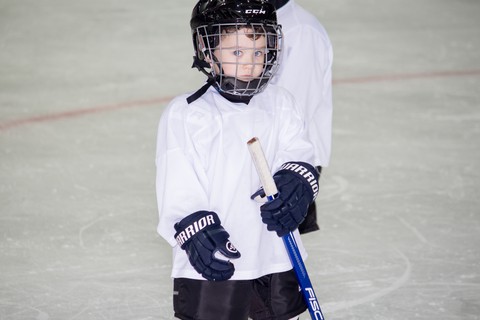
- Fun
- Introducing Basic Skills
- Reviewing Basics Skills
- Refining Basic skills
I honestly have so much fun watching and helping out with this little hockey warriors. They all have so much fun out there and always have smiles on their faces.
It is very important to have many coaches and parent volunteers in order to break the kids into groups and give them focused attention to help develop their skills at an early age.
Its amazing to me watching the change in the kids from day one till the end of season. You can barely remember what they looked like when they first started.
Some places have a junior and senior IP (initiation), while other organizations will blend their players into teams. It all depends on the numbers. You wont be disappointed entering your children into hockey at this early stage.
House League vs Competitive
Before we dive into each division, it is important to know a few things about different skill levels. In certain regions there will be a lot of registered players with a vast amount of skill.
The “House League” is a non-competitive part of hockey. Not to say there isn’t any competition. But this is typically filled with players of any skill level. These teams usually stay within their organization or league and play teams close by.
On the Competitive side there is the “travel” or “representative” (rep) teams, that will travel and play teams from other areas. Not all cities will have all skill levels available, it all depends on size and popularity of hockey.
The best or most “elite” levels of minor hockey are
- ‘AAA’
- ‘AA’
- ‘A’
With ‘AAA’ being the highest skill level of hockey in an area. Most kids need to be exceptionally good at hockey for their age to make one of these teams. And it will come at a cost, but thats for another article.
Under – 9 (U9) (Novice)
Recent changes to this level occurred this season (2019/2020) which saw the entire league across Canada move to a half ice format of hockey. Similar to the U7 (initiation) level.
Although in Toronto, they have slightly different rules when it come to this change. Head to the GTHL website if you want to know more.
When I first heard about this change I was very unsure how it would affect the kids. My son had already played his first year novice (U9) in the traditional 5 on 5 hockey format.
But after researching the change and having meetings with our organization, I began to see the benefits. Here are some facts that I have found on the cross ice/half ice format vs full ice at this level:
- Shots – 6x more shot attempts and 3x shots on goal/player
- Passing – 5x more passes received/player
- Puck Battles – 2x more puck battles/player
- Pass Attempts – 2x more pass attempts/player
- Change of Direction – 2x more change of direction/pivot
These stats were found here.
At the time I am writing this we are almost through the 2019 portion of our season and our kids are having a blast with this fast paced, high scoring style of hockey. And even tho there is no score. The kids keep track.
Every team in our league consists of 8 players plus a goalie.
The kids get 90 second shifts all game long. So that means they get a minute and a half on the ice, sit for a minute and a half and are then right back out there.
In the old 5 on 5 format, there were times where some kids would get a 30-60 second shift and then sit for 2-3 minutes, sometimes longer. This was due to the kids not understanding rolling line changes, which is changing lines (players) without a game stoppage, or having longer times between whistles.
Also most of these players didn’t understand what an offside was, so there was a lot of wasted time and game stoppage.
Yes it is tough driving an hour and a half to a game where there is no score or positions. No competition, but trust me. The kids are having so much fun and getting a ton of ice time which will help them develop all their skills.
Under – 11 (U11) (Atom)
This level of hockey is where we start to introduce team tactics. We get back to the 5 on 5 traditional hockey. There are positions, referees, score, standings, playoff runs.
It can get very serious, but always always need to be FUN for all the kids playing. It is so important to teach these young children sportsmanship, teamwork and respect. Respect to themselves, their teammates, coaches, officials and the other team.
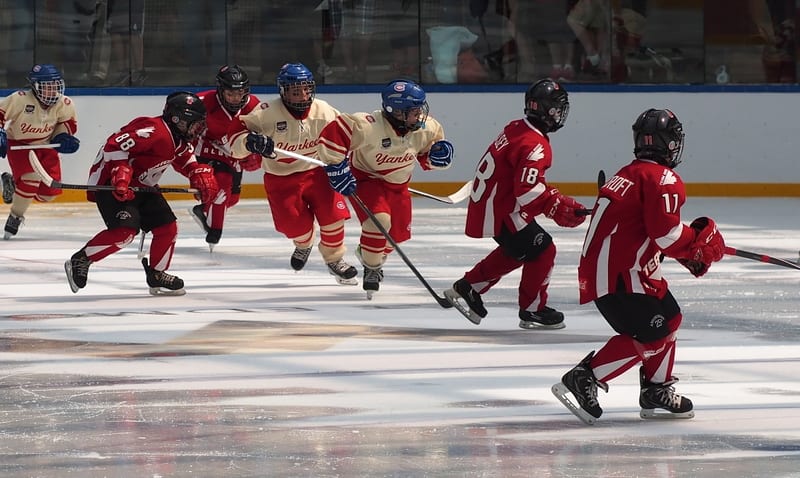
In this division, the focus is on maintaining the technical skills (50%) from earlier years and improving on them. Focusing on individual skills (20%), team tactics (15%), team play (10%) and strategy (5%). These are practice times Hockey Canada recommends.
Under – 13 (U13) (PeeWee)
At this stage in their hockey lives, the kids are really starting to love the game. They are honing in on their skating skills working the edges more.
Improving on team play, developing hockey sense, team tactics, individual skills and technical skills are still the main focus at this point.
In the past this is the age where body checking was introduced.
It has since been moved to Bantam Level for the “rep” levels only.
The decision to remove body checking was due to player safety. Some argue that pushing it later in age will have a negative affect when they actually get to the stage of body contact because they wont know how to properly hit or take a hit.
But it is for the safety of these young children. They are only 11 and 12 after all. It can still get pretty physical when they are in the corner battling for the puck.
Under – 15 (U15) (Bantam)
Once you or our child reaches this point in hockey you are very well versed in the game. They have been playing for close to 10 years. Are starting to hit puberty and their size, strength and speed will really begin to grow over the next few years.
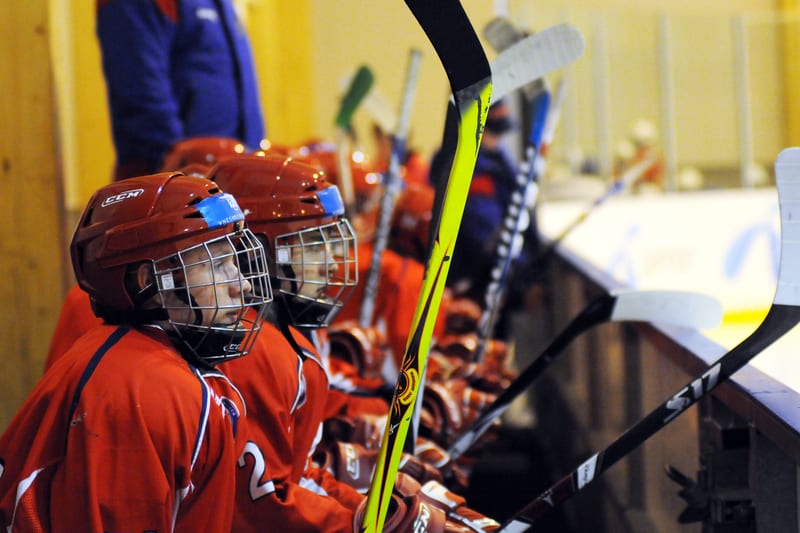
At this level of hockey Body contact will be fully introduced in the “rep” or travel teams only. There isn’t and exact age that is it introduced it is more of a progression throughout the hockey journey.
But this is the level when it is allowed without drawing a penalty. As long as it is clean. Which means shoulder to shoulder, no head shots and absolutely not from behind.
You will be busy going to tournaments, practices and playoff runs. The competition will continue to grow and the pressure to win will be a little more.
Under – 18 (U18) Midget
This level includes 15-17 years olds. In some cities they may break off the 15 year olds into Minor Midget, while the 16-17 year olds move to Major Midget. It will depend organization to organization.
Also some highly skilled players may already be being looked at by Junior teams or leagues such as the OHL or colleges and universities.
But for the average hockey player they will continue their journey in a House League team or ‘AAA’ or lower.
Juvenile (Under 20)
This level is for players who want to keep playing in a minor hockey association but are not playing for a junior team.
Junior (Under 21)
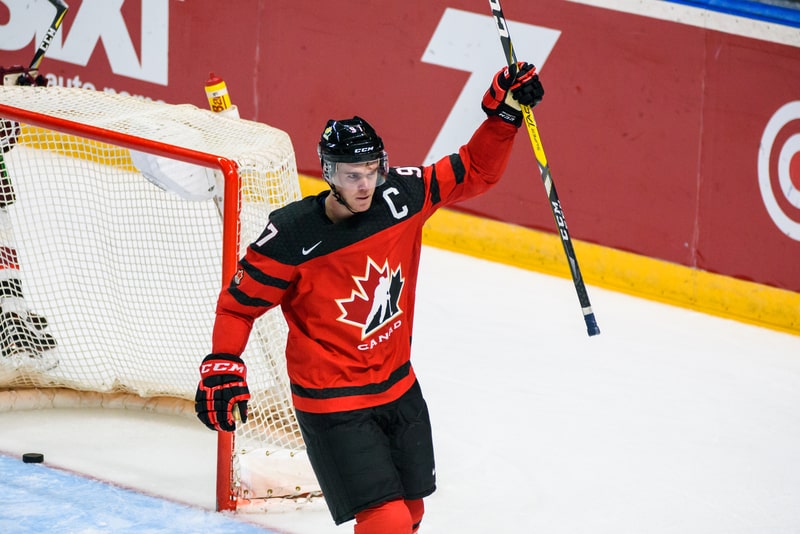
Junior hockey is split into 4 categories in Canada
- Major Junior (WHL, OHL and QMJHL)
- Junior A (Tier II Junior)
- Junior B
- Junior C (in some locations)
The CHL is the major junior league in Canada and consists of the three leagues mentioned above. The winner of each of those leagues play in a national tournament at the end of the year called the Memorial Cup
The best players in these leagues will get drafted to the NHL. Also these leagues will have a draft of their own, bringing up Bantam and Midget players depending on their age.
Junior hockey is very complex, players are eligible for scholarships and NCAA status as well as NHL drafts for the best players. I would check out junior hockey truth, who have a great article going in depth on junior hockey.
United States Divisions and Age Groups
| Division | Age |
| Mite | 8 and under |
| Squirt | 9-10 |
| PeeWee | 11-12 |
| Bantam | 13-14 |
| Midget Minor 15 and under | 15 |
| Midget Minor 16 and under | 15-16 |
| Midget Major 18 and under | 15-18 |
| Junior | 16-20 |
The Wrap Up
This article will give you a good grasp on what to expect throughout your hockey journey from start to finish. Between Canada and the USA it will be very familiar within the levels of hockey and progression throughout.
When you talk about Europe and other countries it may vary as they might have different expectations for their kids.
But in Canada for sure, and most likely the USA, the focus is on Fun, Fair Play and developing a love for the game. If you don’t love the sport you play, than what is the point in playing?
It is important for parents and coaches to always remember these things especially in the beginning.
Thanks for reading and I hope you enjoyed. Until next time.